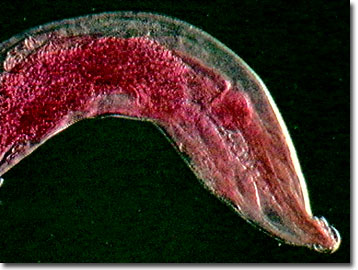Darkfield Digital Image Gallery
Pinworms (Enterobius vermicularis)
As the most common nematode parasite of humans in North America and Europe, pinworms (Enterobius vermicularis) infect more than 400 million people worldwide. Living in the large intestine, pinworm infestations may be asymptomatic or result in mild irritations of the gastrointestinal tract.

Mature female pinworms are about twice as long as the 5-millimeter-long males, which live only until copulation occurs. When she is ready to lay her 10,000 plus eggs, the female nematode crawls out of the host's anus, deposits the eggs on the perianal skin, and then dies. At the average human body temperature of 98.6 degrees Fahrenheit, the eggs develop rapidly and reach their third juvenile stage as infective eggs in approximately 6 hours. The eggs are ingested by another human host and hatch in the small intestine. In about a month, the parasitic nematodes reach maturity and reproduce sexually, reinitiating the life cycle.
A common symptom of a pinworm infestation is perianal itching associated with the nocturnal egg-laying habits of E. vermicularis, which is complicated by secondary bacterial infections associated with scratching. Children, the most commonly infected subpopulation because of close proximity in daycare and classroom situations, and often poor sanitary habits, undergo noticeable changes associated with pinworm parasitic loads including irritability, insomnia, and restlessness. With women as hosts, adult pinworms can also enter the vagina and cause additional discomfort.
Prevention of pinworm infections involves the common sense of washing ones hands routinely, but especially after using the bathroom and before eating. Once infected, bed linens, clothing, carpets, towels, and curtains need to be cleaned since they may be contaminated with eggs. Highly contagious, reinfection is common and therefore once one member of a classroom or family is infested, the whole group may need to be treated medically. Detection of pinworms is made by examining the perianal tissue with a flashlight, preferably very early in the morning, when the pinworms lay their eggs, with the roundworms literally glowing under the bright light. In addition, eggs can be gathered for later examination by using cellophane tape on a stick. The flattened, ovoid eggs are very resistant to dehydration and can even be dispersed in the air. Usually no medical treatment is necessary, although doses of mebendazole and pyrantel pamoate are sometimes prescribed to kill adult parasites, particularly with massive infestations or when treatments for secondary bacterial infections or other serious symptoms are required.
Contributing Authors
Cynthia D. Kelly, Thomas J. Fellers and Michael W. Davidson - National High Magnetic Field Laboratory, 1800 East Paul Dirac Dr., The Florida State University, Tallahassee, Florida, 32310.
BACK TO THE DARKFIELD IMAGE GALLERY
BACK TO THE DIGITAL IMAGE GALLERIES
Questions or comments? Send us an email.
© 1995-2025 by Michael W. Davidson and The Florida State University. All Rights Reserved. No images, graphics, software, scripts, or applets may be reproduced or used in any manner without permission from the copyright holders. Use of this website means you agree to all of the Legal Terms and Conditions set forth by the owners.
This website is maintained by our
Graphics & Web Programming Team
in collaboration with Optical Microscopy at the
National High Magnetic Field Laboratory.
Last Modification Friday, Nov 13, 2015 at 01:19 PM
Access Count Since September 17, 2002: 51000
Visit the website of our partner in introductory microscopy education:
|
|
